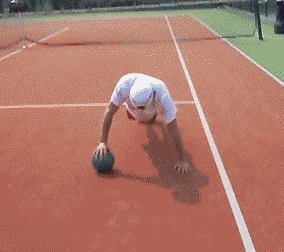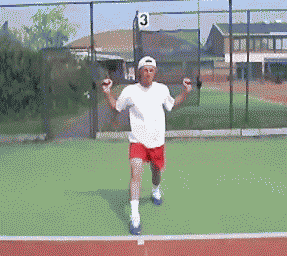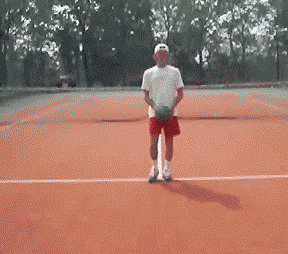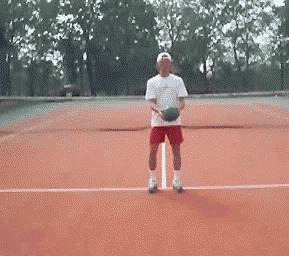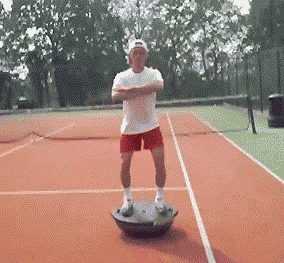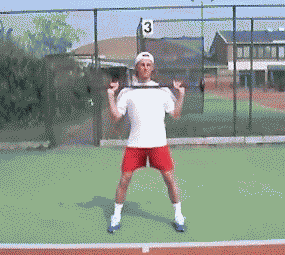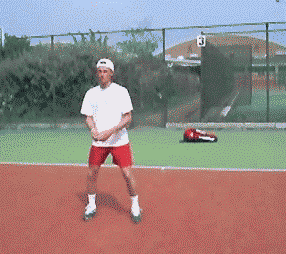|
TennisOne Lessons Top Ten Training Tips for Conditioning Success Paul Gold Many people seem to have forgotten that the main objective of every strength training program you do should be to improve your performance. If your sport was power lifting, that would mean lifting heavy weights, but because your sport is tennis – that means improving your ability on the court. I’ve seen many players over the years that have the top bench press in the club – but are 0-20 in matches for the season! Follow my top ten tips to ensure your success. 1) Bodyweight before external resistance Even now I’m still surprised at the eagerness of some people to get their players “under the bar.” In my view, a player has no business using heavy external loads if he/she cannot stabilize, control and move efficiently with only their own bodyweight. Some of the strongest athletes on the planet are gymnasts who spend most of their time manipulating their own bodies around the gym – think about it!
If you can’t stabilize your shoulder girdle and core doing push-ups then there is no way you should be under a bench press bar. A strength program in the beginning stages may actually include no weights whatsoever, but that will work better and faster than a program that relies primarily on weights and machines - muscle recruitment and control are far more important than maximal strength. Without control – any strength is useless! 2) Train the 5 Powers This basically refers to the following:
3) Train unilaterally and multi-planar Most strength training programs train you in one plane (sagittal) with bilateral (two) movements, however, the majority of sport takes place in all three planes simultaneously, with primarily unilateral (many) movements – so train in this manner! An interesting fact to consider is that 85% of the gait cycle (walking, running) is spent with one leg in the air and most of the shots you play rely primarily on the dominance of one leg, therefore, all your leg training should include the following exercises - split squats, step ups, and lunge variations.
4) Use ALL primary methods to develop strength.
Traditional strength training programs have wrongly borrowed from outdated body building concepts and focused overwhelmingly on building maximum strength, however, you need to remember that the most important factor is the rate of force production. In the world of sport – speed is King! 5) Variation
Everybody knows that a training load should be progressively increased – don’t they? However, not many people understand that the training stimulus must also be progressively and periodically varied. If you spend too much time on one program you’ll habituate to the positive aspects while accumulating the negative aspects – this creates performance plateaus and injury situations. Keep things varied – keep your body guessing. Make sure the roles of strength and conditioning and skill training are separate. Overloading a technique affects the mechanics of the technique negatively. If there is any danger that the training you are doing forces you to change your technique then stop immediately! 7. Balance your training
Make sure you address pushing and pulling on both horizontal and vertical planes and attempt to balance the loading. If you are bench pressing 400lbs but can only do a chest supported row with 50lbs your shoulder girdle is going to suffer. If you can’t handle the same loads for two opposing movements then increase the volume of the weaker movement (e.g. by doing an extra exercise or an extra set or two) to compensate. 8. Get out of the Weight Room Try some other forms of training: sled dragging, uphill sprints, stadium stairs. This runs alongside tip 5 – keep it fresh!
9. Train the antagonists The speed of a serve or a forehand is determined largely by the ability of the antagonist (opposing muscle to main muscle) to eccentrically decelerate your joint action efficiently and prevent joint injury. If you cannot safely and effectively slow down an action, then it will not allow you to achieve full acceleration. If you are not training the antagonists eccentrically - you are not training deceleration. And if you are not training deceleration you cannot be training acceleration. Try catching and slowing down a med ball from your partner (as you take it back into a forehand or backhand). 10. Full Front Squats This exercise is fantastic! It may even be the single most athletic exercise you do. You’ll get core, wrist, knee, hip, shoulder and ankle strength and flexibility in a single movement.
11. Extension! Triple extension (ankle, knee, and hip) is a valuable component when training. One of the options open to you is Olympic lifting.
If you’re not comfortable with Olympic lifts then add jump and/or medicine ball training to your program. Do not get caught up in the numbers game and do not confuse gym improvements with on court improvements The greatest players in the world do not have the greatest bench presses in the world. What the greatest players in the world do have is an ability to produce useable force on the court. Improve tennis performances, not your lifting numbers.
Paul Gold has a Masters degree in Sports Sciences and is a Performance Enhancement Specialist and Speed Agility Quickness trainer. For information about products and services contact via www.powertennistraining.com |
